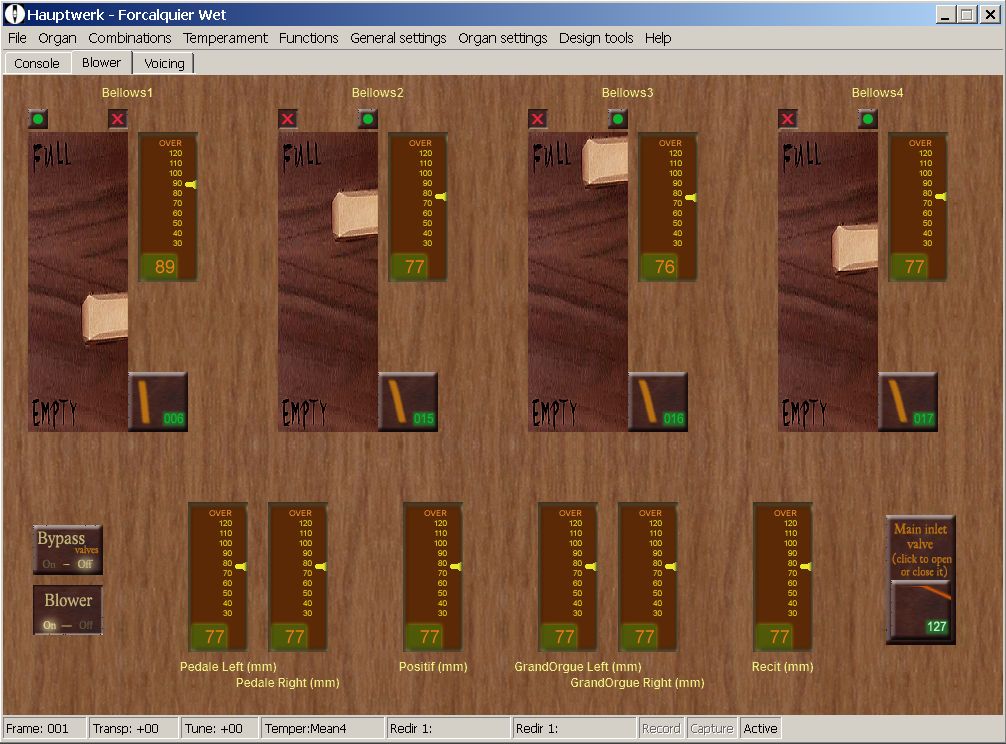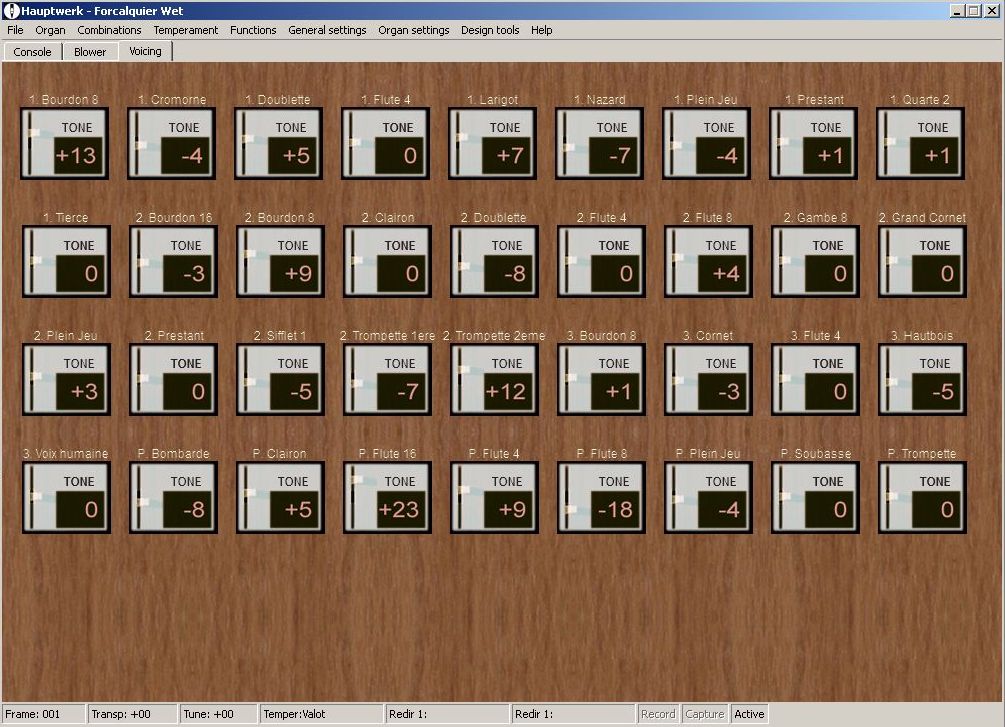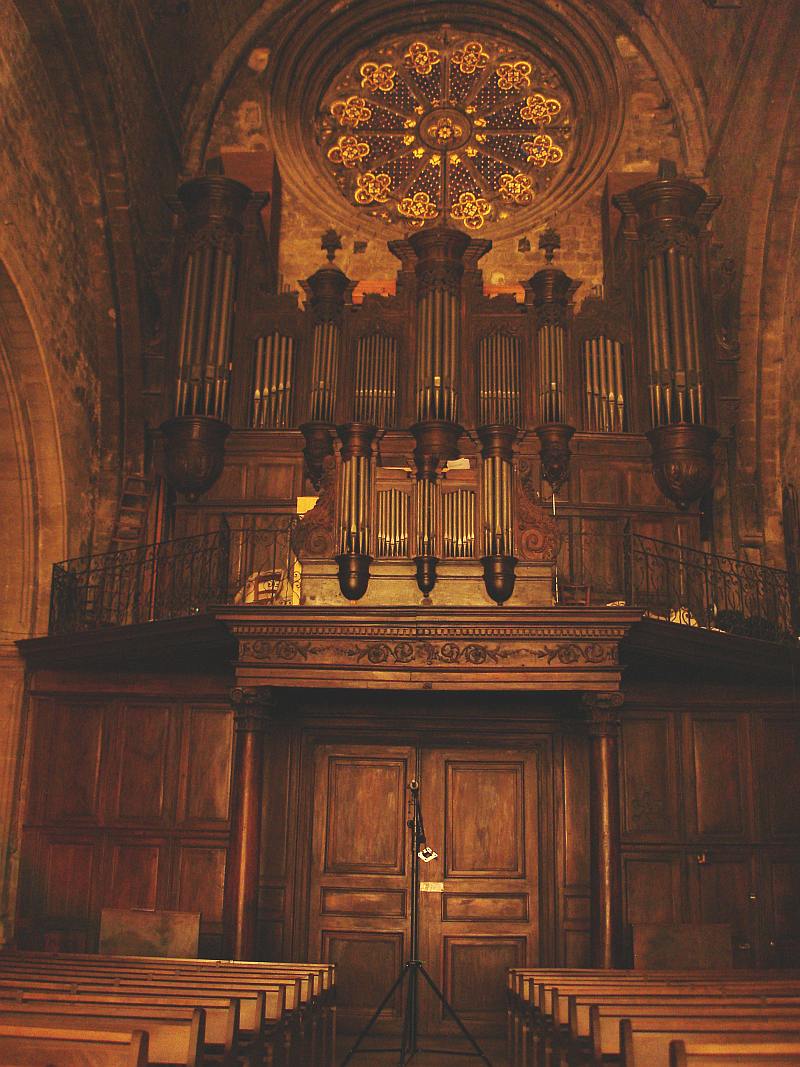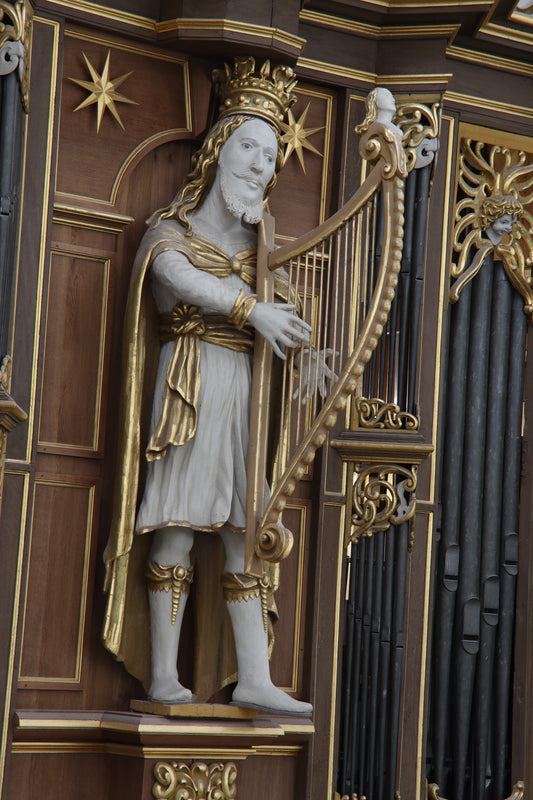Sonus Paradisi
Forcalquier, 1627 [Hauptwerk]
Forcalquier, 1627 [Hauptwerk]
No se pudo cargar la disponibilidad de retiro
The Forcalquier Organ Model (1627-2000)
The history of the organ in the church of Forcalquier is very turbulent and only a part of the material remained from the baroque period, from the original organ. Most of it comes from a 19th and 20th century restorations.
The cathedral in a small and picturesque French city called Forcalquier had a small organ with 9 stops built by Pierre Marchand in 1627.
The composition and the timbre of the organ is typically French, although rather sharp, "chiffy", with a strong feeling of „inégalité“, i. e. there are numerous voicing breaks where suddenly the timbre of the stop changes. The most prominent one is the division of the Voix humaine of the Récit, which is in fact composed of two different stops, one for the Bass part and the other for the Treble part of the keyboard compass.
Presented to you by Leonart Studio, your authorised reseller for Sonus Paradisi in Switzerland (shipped internationally). Get your digitally sampled historical organs for the use with the Hauptwerk virtual instrument software.
Share this Sample Set
![Forcalquier, 1627 [Hauptwerk]](http://artful.shop/cdn/shop/files/ss_forcalquier1.jpg?v=1692893506&width=1445)
Specification (stop list)
-
Manual I
Positif de dos (54 keys)
Bourdon 8´ (2000)
Prestant 4´ (1627+1847)
Flute à cheminée 4´ (2000)
Nazard 2 2/3´ (1627)
Doublette 2´ (2000)
Quarte 2´ (2000)
Tierce 1 3/5´ (1627)
Larigot 1 1/3´ (1627+2000)
Plein-Jeu IV (2000)
Cromorne 8´ (2000)*
*year the stop was made -
Manual II
Grand Orgue (54 keys)
Bourdon 16´ (1847)
Gambe 8' (1847)
Bourdon 8´ (2000)
Flute 8´ (1847+1932) - a mild Principal
Prestant 4´ (2000)
Flute 4´ (1847+1932)
Doublette 2´ (2000)
Sifflet 1´ (1847+2000)
Cornet V (1627) - dessus
Plein Jeu V (2000)
1ère Trompette 8´ (1847) - sharp one
2ème Trompette 8´ (1847) - mild one
Clairon 4´ (1847) -
Manual III
Récit (54 keys)
Bourdon 8´ (1847+1932)
Flute 4´ (1847+1932)
Cornet III (2000)
Dessus de Hautbois 8´ (1847)
Voix Humaine 8´ (1847+2000) - bass / dessus -
Manual IV
-
-
Pedal
Pédale (30 keys)
Soubasse 16´ (2000)
Flute 16´ (1847)
Flute 8´ (2000) - a mild Principal
Flute 4´ (2000) - a mild Principal
Plein Jeu IV (2000)
Bombarde 16´ (1847)
Trompette 8´ (1847+2000)
Clairon 4´ (1847+2000) -
Other specification
Couplers:
I / Ped.
II / Ped.
III/ Ped.
I / II - Positif to Grand Orgue
III / I - Récit to Positif, not original, added only virtually
Tremulants:
Positif tremulant, not original, added only virtually
Récit tremulant, not original, added only virtually
History
The Forcalquier Organ Model (1627-2000)
The history of the organ in the church of Forcalquier is very turbulent and only a part of the material remained from the baroque period, from the original organ. Most of it comes from a 19th and 20th century restorations.
The cathedral in a small and picturesque French city called Forcalquier had a small organ with 9 stops built by Pierre Marchand in 1627. It is said that during the time of the Revolution, the church and the organ served for the embellishments of the feasts of the new regime. In 1803, the Christian worship was restored in the church. Half a century later, Prosper Antoine Moitessier rebuilt the organ completely, reusing also the ancient material. The Grand orgue had now 22 stops, a Récit expressif (enclosed in a swell-box) and Pedal with 4 stops. The organbuilders Cavaillé-Coll – Mutin made further reconstruction in 1932. They extended the pedal board range and changed the action to the pneumatic one. Recently, the organ was carefully restored and enlarged in two steps in 1981 and 2000 by Alain Sals. The action was changed back to the mechanical one, new Positif de dos was installed using the remaining old pipes, some new stops were added, so that now the organ has 36 speaking stops. The swell-box of the Récit was most probably removed during this restoration.
The composition and the timbre of the organ is typically French, although rather sharp, "chiffy", with a strong feeling of „inégalité“, i. e. there are numerous voicing breaks where suddenly the timbre of the stop changes. The most prominent one is the division of the Voix humaine of the Récit, which is in fact composed of two different stops, one for the Bass part and the other for the Treble part of the keyboard compass. The specification given below gives also the idea how old every stop is, so, whether it comes from Marchand (1627), Moitessier (1847) or Cavaillé-Coll-Mutin (1932) or Sals (2000).
Features
Features and Screenshots
The samples are available in 24bit/48kHz resolution. Hauptwerk v.4.20 and higher supported. There are multiple releases and, at times, also multiple attack samples. It is wet sample set. The amount of reverberation is rather high (about 4 seconds). The spatial difference of the location of the Positif de dos and the rest of the instrument is well pronounced in the recording. The Positif appears to be more "near" to the performer than the rest of the organ. The virtual model offers very clear, present and detailed sound.
Large compass of manuals as well as of the pedal board allows for the performance of almost any organ music. The wide range of sound colors also contributes to the sound possibilities of this mid-sized instrument. Therefore, it seems to suit the needs not only of the French compositions, but also other musical traditions, including modern organ music.
Key midi velocity is used to controll the attack of the pipes (the feature common to all Sonus Paradisi sample sets). However, this is useful only if you use midi velocity sensitive keyboard! If your physical console is not equipped with a velocity sensitive keys, it will be necessary to switch off the midi velocity sensitivity in Hauptwerk (General settings) to prevent unexpected errors in the note attack.
Forcalquier organ model was designed so that it fits into the 1024x768 pixels screen (smaller screens or even laptops).
In order to increase the readability of the stop labels and the comfort of switching the stops when using a touch screen, we decided to offer clickable labels instead of modeling virtual drawstops. Simply click on the label itself and it will engage/disengage the stop. The drawstops which appear "behind" the semi-transparent labels are not operational. The couplers and tremulants foot switches above the pedal board are operational (including their labels).
There are also Generals 1-5 added for the comfort of modern players, they appear on the top of the music desk (Notenpult). To set the general, engage first the set button "S" (the light will be switched on). After setting the right registration, store it, by pressing (or clicking) on one of the 5 Generals. Having done that, do not forget to disengage the "S" button (the light will be switched off) or you will override your setting.
Every division has labels of certain color: Positif is green, Grand Orgue is blue, Pedal is yellow and the Récit is red.
Screenshot - Wind modeling
It is generally agreed by experts, that it is the wind behavior which makes the beauty of the organ sound. In early times, wedge bellows were used in organs which were pulled up by "calcants". There were usually several sets of bellows to feed the organ so that the wind achieved some stability. Nevertheless, the procedure of pumping and also the changing torque of the falling moving board as the bellows were deflating, caused slight changes in pressure, slight oscilations which affected the pipe speech. Also, the wind stability was so delicate that playing on one manual with just one or two stops affected the speech of pipes played on a different manual. After the parallel rise bellows were invented, and after organ blowers invaded churches, these subtle wind behavior was lost to great deal. With the help of Hauptwerk, we can now model the original situation of the hand pumped bellows and indeed, it is completely new experience of the organ sound.
Four bellows are seen, all feeding one common trunk where all the divisions are fed from. The bellows are of the wedge type and are operated by hidden calcants (in fact, a hidden blower operating only when the bellows is being filled). When the bellows are full, they are attached to the wind trunk of the organ and the air begins to flow from the bellows to the organ. In this way, the bellows are emptied after some time and they are filled again by calcants. The indication of the bellows extension is shown. The small icons above this indication are showing the state of the inlet and exhaust valves of the given bellows. The left is inlet, the right is the exhaust valve. These operate automatically, but they are also clickable, so you can detach any bellows at any moment from the wind system of the organ if desired! Besides the moving board indicators, there are also the pressures inside the bellows and inside the windchests indicated. This setting of the bellows imitates the ancient way of the organ wind system construction and adds to the aliveness of the pipe sound due to small instabilities generated in the wind ways when under heavier load. In the left bottom corner, there is the blower switch (you can turn the "calcants" off or on) - if you switch it off, the bellows will deflate after a while and the organ will be without wind - i.e. without any sound. Also, you can alternatively choose to bypass the non-return valve present at the foot of each the set of bellows. This can produce different behavior of the wind system if desired. In the right bottom corner, there is the main valve shown in a form of continuous controller. Clicking on the valve, you can make the aperture of the wind trunk wider of narrower, allowing more or less air to the whole system if desired.
Screenshot - User voicing
By dragging the voicing handle up or down, you can change the timbre of entire stop at once. Up - more brilliant sound, down - less brilliant sound. This simple and powerful voicing device works also in the Basic Hauptwerk edition, where the native per-pipe-voicing is disabled.




Requirements
Hauptwerk v.4.20 and higher supported.
Memory consumption
Full instrument in 16-bit depth, memory compression enabled, all releases, all attack samples: 3.7 GB.
If you want to get most out of the samples, load it at least in 20-bits (possibly with the memory compression enabled). If you have to make compromises, it is always better to use the memory compression while loading in higher bit depth, than using the samples without the memory compression at lower bit depth! The higher bit depth, the less noise (hiss) introduced by the audio engine in Hauptwerk!
This Hauptwerk Sample Set is presented to you by Leonart Studio, an authorised reseller for the manufacturer Sonus Paradisi in Switzerland (shipping internationally). Enjoy this digitally sampled organ library for the use with Hauptwerk software and start expanding your historical organ collection today.
More Hauptwerk Sample Sets
-
Casavant, 1995 [Hauptwerk]
Proveedor:Sonus ParadisiPrecio habitual CHF 174.90Precio habitualPrecio unitario / por -
Reuter, 1928 [Hauptwerk]
Proveedor:Sonus ParadisiPrecio habitual CHF 473.00Precio habitualPrecio unitario / por -
Rotterdam Hoofdorgel, 1973 [Hauptwerk]
Proveedor:Sonus ParadisiPrecio habitual A partir de CHF 330.00Precio habitualPrecio unitario / porCHF 958.10Precio de oferta A partir de CHF 330.00Oferta -
Groningen, 1450-1740 [Hauptwerk]
Proveedor:Sonus ParadisiPrecio habitual A partir de CHF 658.90Precio habitualPrecio unitario / porCHF 1,681.90Precio de oferta A partir de CHF 658.90Oferta -
Goerlitz, 2006 [Hauptwerk]
Proveedor:Sonus ParadisiPrecio habitual A partir de CHF 328.90Precio habitualPrecio unitario / por -
Bückeburg, 1997 [Hauptwerk]
Proveedor:Sonus ParadisiPrecio habitual A partir de CHF 1.10Precio habitualPrecio unitario / por -
Brasov, 1839 [Hauptwerk]
Proveedor:Sonus ParadisiPrecio habitual CHF 418.00Precio habitualPrecio unitario / por -
St. Omer, 1717-1855 [Hauptwerk]
Proveedor:Sonus ParadisiPrecio habitual CHF 323.40Precio habitualPrecio unitario / porCHF 410.96Precio de oferta CHF 323.40Oferta -
Stellwagen organ, St. Marien, Stralsund (1659)
Proveedor:Sonus ParadisiPrecio habitual CHF 858.00Precio habitualPrecio unitario / por -
![Clavichord Model [Hauptwerk]](//artful.shop/cdn/shop/files/ss_clavichord.jpg?v=1724310155&width=533) Agotado
AgotadoClavichord Model [Hauptwerk]
Proveedor:Sonus ParadisiPrecio habitual CHF 33.00Precio habitualPrecio unitario / por


![Casavant, 1995 [Hauptwerk]](http://artful.shop/cdn/shop/files/ss_casavant1.jpg?v=1693319885&width=533)
![Reuter, 1928 [Hauptwerk]](http://artful.shop/cdn/shop/files/ss_Reuter1.jpg?v=1693321024&width=533)
![Rotterdam Hoofdorgel, 1973 [Hauptwerk]](http://artful.shop/cdn/shop/files/ss_RotterdamMain1.jpg?v=1693279529&width=533)
![Groningen, 1450-1740 [Hauptwerk]](http://artful.shop/cdn/shop/files/ss_Groningen1.jpg?v=1693275425&width=533)
![Goerlitz, 2006 [Hauptwerk]](http://artful.shop/cdn/shop/files/ss_goerlitz1.jpg?v=1692995837&width=533)
![Bückeburg, 1997 [Hauptwerk]](http://artful.shop/cdn/shop/files/ss_bueckeburg1.jpg?v=1692967628&width=533)
![Brasov, 1839 [Hauptwerk]](http://artful.shop/cdn/shop/files/ss_brasov1.jpg?v=1692967057&width=533)
![St. Omer, 1717-1855 [Hauptwerk]](http://artful.shop/cdn/shop/files/ss_omer1.jpg?v=1692904128&width=533)

![Clavichord Model [Hauptwerk]](http://artful.shop/cdn/shop/files/ss_clavichord.jpg?v=1724310155&width=533)